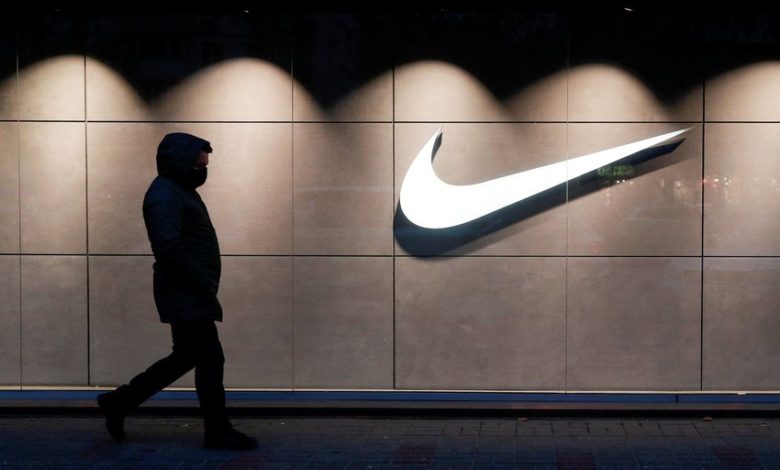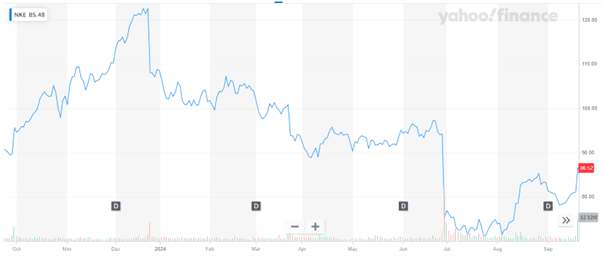
Nike (NYSE:NKE) has recently undergone significant leadership changes as CEO John Donahoe is stepping down, with longtime company veteran Elliott Hill taking over the reins. This transition comes at a crucial time for the sportswear giant, which is in the midst of restructuring efforts aimed at pivoting from retail partnerships to direct sales to consumers. Hill’s appointment, following a 32-year tenure at Nike, is seen as a move to bring stability and company knowledge back to the leadership table. While Hill is recognized for his deep understanding of the brand, consumer behavior, and marketing, he faces a challenging landscape. Under Donahoe's leadership, Nike prioritized digital transformation and direct-to-consumer sales, often at the expense of innovation in product design and retail partnerships. This strategy left the company vulnerable to increasing competition in the footwear industry and led to stagnating revenue growth. With revenue up just 1% in fiscal 2024 and guidance lowered for fiscal 2025, Hill inherits a company facing mounting pressure to deliver results. Let us take a closer look at all the critical challenges that he must navigate to successfully lead Nike into its next phase of growth.
Restoring Innovation and Product Development
One of the primary challenges for Elliott Hill is to reignite innovation at Nike. Under Donahoe, the company focused heavily on direct-to-consumer strategies, scaling its online presence and reducing reliance on third-party retailers. While this move had short-term benefits, critics argue that it distracted from the company’s traditional strengths in innovation and product development, leaving room for competitors to gain ground. Hill must now focus on reviving Nike’s reputation for creating cutting-edge, high-performance footwear that excites consumers and sets the company apart from rivals. Nike’s competitors, such as Adidas and Under Armour, have increasingly narrowed the gap in product offerings, particularly in the lifestyle and performance segments. Nike's recent earnings call pointed to underperformance in key categories like lifestyle footwear, despite promising growth in basketball and running. To reclaim its position as a leader in innovation, Hill will need to accelerate the company’s multiyear innovation pipeline. This includes leveraging Nike's Bowerman Footwear Lab and "Speed Lane" product development initiatives to bring new designs to market faster. However, restoring innovation will require substantial investment in R&D and a renewed emphasis on fostering creativity within Nike's design teams. Hill must also ensure that Nike strikes a balance between performance products and lifestyle offerings to meet evolving consumer preferences.
Rebuilding Relationships with Retail Partners
Another significant hurdle for Hill will be rebuilding Nike’s relationships with key retail partners. The company’s strategic shift toward direct sales under Donahoe led to a reduction in inventory available to traditional retailers, straining those partnerships. While Nike saw some success with its own digital and physical storefronts, the decline in wholesale sales impacted the overall performance of the business. Retailers such as Foot Locker, which have long been important channels for Nike’s products, were left with reduced stock and fewer exclusive launches, diminishing their ability to drive traffic and sales. This has created opportunities for competitors to fill the gap, particularly in regions where Nike’s own stores are less prevalent. For Hill, mending these relationships will be essential to recapturing lost market share and ensuring that Nike’s products remain readily available to a broad audience. He will need to navigate the delicate balance between sustaining the company’s direct-to-consumer momentum while restoring trust and collaboration with retail partners. One approach could involve creating more exclusive product lines or collaborations specifically for key retailers, ensuring they have unique offerings that consumers can’t find elsewhere. However, Hill must also address the operational challenges of inventory management and supply chain efficiency to prevent shortages and delays that have frustrated both retailers and consumers in recent years.
Navigating Global Economic and Market Headwinds
Hill’s leadership comes at a time when Nike faces considerable global economic headwinds. The company’s earnings call for Q4 fiscal 2024 highlighted several challenges, including weakening consumer demand in key markets like Greater China, continued macroeconomic uncertainty in Europe, and foreign exchange headwinds. These factors have already led Nike to lower its guidance for fiscal 2025, expecting mid-single-digit revenue declines. In Greater China, one of Nike’s most critical growth markets, the company saw a significant drop in brick-and-mortar traffic, compounded by uneven digital sales performance. Similarly, the European market remains volatile, with consumers tightening their spending amidst economic concerns. To successfully navigate these global headwinds, Hill will need to strengthen Nike’s positioning in international markets. This may involve adapting the company’s product offerings to local consumer preferences and investing in localized marketing campaigns to resonate more effectively with diverse audiences. Additionally, Hill must address supply chain inefficiencies and mitigate the impact of foreign exchange fluctuations on revenue. Improving cost controls while maintaining quality and innovation will be essential to preserving margins in this challenging environment. With global market dynamics constantly shifting, Hill’s ability to react swiftly and strategically to economic pressures will be key to keeping Nike competitive.
Final Thoughts

Source: Yahoo Finance
We can see Nike’s stock taking a beating over the past year though the news of Elliott Hill stepping into the role of CEO did lead to some level of optimism from the market. Nike’s LTM EV/ Revenue multiple has also contracted from 3.33x to 2.53x over the past 12 months indicating a weaker investor perception with respect to its future. We believe that Elliott Hill faces an uphill battle on several fronts. Restoring innovation, rebuilding retail relationships, and navigating global economic challenges are just a few of the critical areas that will define his leadership. While his deep company roots and understanding of the brand position him well for the role, it is important for investors to weigh the risks and rewards. Nike’s restructuring efforts and focus on new product development offer long-term growth potential, but the near-term challenges of global market pressures and strained retail partnerships cannot be ignored which is why we consider Nike a risky investment at current levels.



